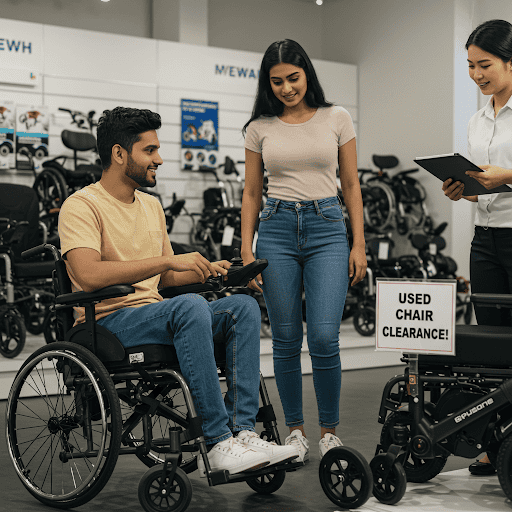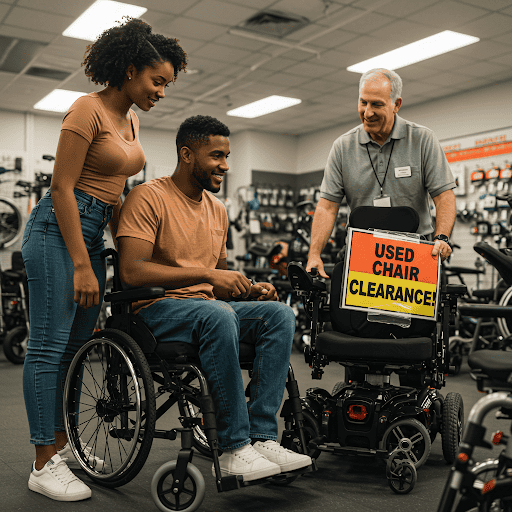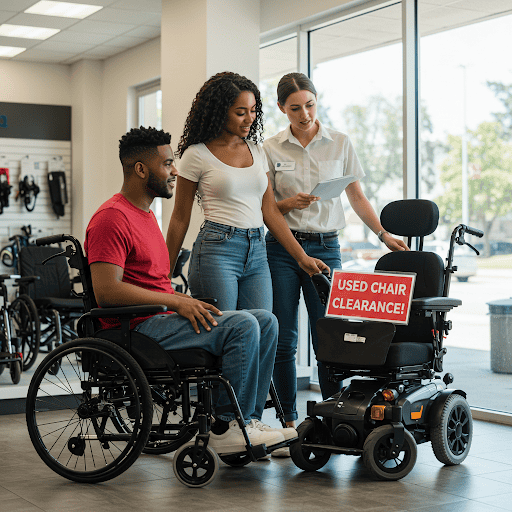Take a moment and picture this: The exhilarating feeling of freedom – the wind tussling your hair as you explore a new park, or the joy of effortlessly keeping up with loved ones on a bustling city street. Now, picture that same freedom being out of reach for you – or even a loved one, because the cost of a new wheelchair feels like its out of your reach.
For many individuals facing mobility challenges, regaining independence often hinges on finding the right wheelchair. But the sticker shock of brand-new models can be a major hurdle. This is where the world of used wheelchairs steps in, offering a cost-effective path towards regaining your life-changing freedom. However, navigating the used wheelchair market requires a keen eye and a focus on both safety and comfort. This guide will arm you with the knowledge you need to find the perfect used manual or electric wheelchair, allowing you to roll into independence with confidence.
Understanding Your Needs: The Perfect Fit for Freedom
Before diving into the subject of shopping for a used manual or electric wheelchair, it’s crucial to take a step back and assess your individual needs. This self-evaluation will be your roadmap to finding a wheelchair that offers not just newfound mobility, but also optimal comfort and safety. Let’s explore some key factors to consider:
A. Manual vs. Electric Wheelchairs:
The type of wheelchair you choose hinges largely on your physical capabilities.
- Manual Wheelchairs: These wheelchairs are propelled by the user’s hands on the handrims. They offer excellent maneuverability in tight spaces and provide a great workout for upper body strength. However, propelling a manual wheelchair for extended periods or over long distances can be tiring, especially for individuals with limited upper body strength or endurance.
- Electric Wheelchairs: Electric wheelchairs offer motorized propulsion, taking the strain off your upper body and allowing you to cover longer distances effortlessly. This makes them ideal for those with limited upper body strength or for navigating larger areas. However, electric wheelchairs can be bulkier than manual models and may not navigate tight spaces as easily. Additionally, battery life and portability are important considerations with electric wheelchairs.
B. Considering Your Environment:
Where you plan to use your used manual or electric wheelchair most frequently will influence the features you prioritize.
- Indoor vs. Outdoor Use: Indoor environments typically have wider doorways and smoother surfaces. A standard wheelchair might suffice here. For outdoor use, however, features like larger wheels, a more rugged frame, and good ground clearance become important to navigate uneven terrain or obstacles.
- Portability Needs: If you plan to travel with your wheelchair, portability becomes a key factor. Consider lightweight, folding wheelchairs that can be easily stowed in a vehicle. Some electric wheelchairs even come in portable models that can be disassembled for easier transport.
Inspecting a Used Wheelchair: Ensuring a Safe and Smooth Ride

Finding a used manual or electric wheelchair that ticks all your needs boxes is just the first step. A thorough inspection is crucial to ensure the chair is in safe working order and offers the level of comfort you deserve. Here’s what to look for when giving your potential next wheelchair a once-over:
A. Frame:
The frame is the backbone of your wheelchair, literally. Its condition is paramount for safety and stability.
- Material and Durability: Wheelchair frames are typically made from steel, aluminum, or titanium. Steel frames are the most durable but also the heaviest. Aluminum offers a good balance between weight and strength, while titanium is the lightest but most expensive option. Choose a material that suits your needs and lifting capabilities.
- Cracks, Dents, and Rust: Inspect the frame meticulously for any cracks, dents, or signs of rust. These imperfections can compromise the structural integrity of the frame and pose a safety risk. Pay close attention to welds, which are particularly vulnerable to cracking. A small chip in the paint is likely cosmetic, but deeper scratches or exposed metal could indicate rust lurking beneath.
B. Wheels and Tires:
The wheels and tires are your connection to the ground, impacting both maneuverability and comfort.
- Solid vs. Pneumatic Tires: Solid tires are puncture-proof but offer a less comfortable ride. Pneumatic tires, filled with air, provide a smoother ride but are susceptible to flats. Consider your environment and prioritize puncture resistance if you’ll be navigating rough terrain frequently. With pneumatics, check the tread depth to ensure they have enough life left and inspect for any bulges or cracks in the sidewalls.
- Brakes: The brakes are a critical safety feature. Ensure they engage smoothly and firmly without excessive pressure required. Test them on a slight incline to confirm they hold the chair securely. Look for any play or looseness in the brake levers or cables, which could indicate a need for adjustment or replacement.

Additional Considerations: Fueling Your Long-Term Freedom
Finding a used manual or electric wheelchair that fits your needs and is in good condition is fantastic! But to ensure a smooth ride into the future, there are a few additional considerations to factor in:
A. Battery Life (Electric Wheelchairs Only):
For electric wheelchairs, battery life is a key factor influencing your range and overall satisfaction.
- Battery Age and Condition: Just like any battery-powered device, the older a wheelchair battery gets, the less capacity it will hold. Ideally, try to get information on the age of the battery and inquire about any recent replacements. If possible, take the wheelchair for a test drive to gauge how long the battery lasts under typical use.
- Expected Range: Understanding the wheelchair’s typical range on a single charge is essential. This will help you determine if it will meet your daily needs without leaving you stranded. Factors like battery age, terrain, and user weight can all impact range, so aim to get a realistic idea of how far you can comfortably travel on a single charge.
B. Warranties and Service Contracts:
While a used wheelchair represents significant savings, unexpected repairs can quickly eat into those savings. Let’s explore some ways to manage potential costs.
- Remaining Warranties: See if any manufacturer’s warranties remain on the used wheelchair. This can provide valuable protection in case of major component failures.
- Service Contracts: Consider purchasing a service contract from a qualified service provider. This can offer peace of mind by covering routine maintenance and repairs at a predictable cost.
C. Maintenance Needs:
Just like any vehicle, a wheelchair requires regular maintenance to function optimally and avoid costly breakdowns.
- Service History: Inquire about the service history of the used wheelchair. Ideally, the previous owner should have had the chair regularly serviced by a qualified technician. This proactive maintenance can extend the lifespan of the wheelchair and prevent major issues down the road.
- Research Common Maintenance Needs: Familiarize yourself with the specific maintenance needs of the wheelchair model you’re considering. This will help you budget for future tune-ups and part replacements.
Where to Find Used Wheelchairs: Unveiling Your Treasure Trove

Now that you’re armed with the knowledge to assess your needs and inspect a used wheelchair, it’s time to explore the treasure trove of options available! Here are some of the most common places to find a used manual or electric wheelchair:
A. Medical Equipment Suppliers:
Medical equipment suppliers often carry a selection of used wheelchairs that have been inspected, refurbished, and brought back to top condition.
- Benefits: Peace of mind knowing the wheelchair has been professionally inspected and serviced. You may also receive some form of warranty or guarantee on the used wheelchair. Additionally, reputable suppliers can offer expert advice to ensure you find the right fit.
- Considerations: The selection of used wheelchairs may be limited compared to online marketplaces. Prices might also be slightly higher than what you might find from a private seller.
B. Online Marketplaces:
The internet offers a vast marketplace for used wheelchairs, allowing you to browse a wide variety of options from individual sellers.
- Benefits: Potentially wider selection of wheelchairs to choose from, with a chance to find great deals. You can also find used wheelchairs specific to your needs, such as lightweight travel models or sports wheelchairs.
- Considerations: Since you likely won’t be able to physically inspect the wheelchair before purchase, exercise caution and ask detailed questions about the wheelchair’s condition, including any damage or repairs. Use secure payment methods with buyer protection whenever possible. Be wary of deals that seem too good to be true.
C. Charity Organizations:
Some charitable organizations offer used wheelchairs at discounted prices to those in need.
- Benefits: The most affordable option, often allowing you to regain mobility without breaking the bank. This can be a lifesaver for individuals with limited financial resources.
- Considerations: The selection and availability of wheelchairs may be limited. You might need to meet specific eligibility criteria to qualify for a used wheelchair through a charity.

Conclusion: Charting Your Course Towards Freedom on Wheels
Finding the perfect used manual or electric wheelchair is an empowering journey that unlocks a world of newfound independence. It’s about reclaiming the ability to explore your surroundings, to connect with loved ones, and to rediscover the simple joys of navigating your world with ease. Remember, prioritizing safety and comfort is paramount throughout this process. By carefully assessing your needs, thoroughly inspecting the wheelchair, and considering additional factors like warranties and maintenance, you can confidently steer yourself towards a future brimming with possibility.
Safety and Comfort: The Pillars of Your Mobility
A used wheelchair should never be a compromise on safety. The inspection process outlined earlier equips you to identify potential hazards and ensure the chair functions smoothly. A sturdy frame, well-maintained brakes, and properly inflated tires are all essential for safe maneuvering. Comfort is equally important. The right wheelchair should provide proper support, minimize pressure points, and allow for optimal positioning to prevent discomfort and pain. Taking the time to test drive the wheelchair and ensure a good fit is crucial for long-term comfort and enjoyment.
Embrace Expert Guidance: A Helping Hand on Your Path
While this guide equips you with valuable knowledge, consulting with a healthcare professional like an occupational therapist can provide personalized guidance that takes your unique needs into account. They can assess your specific limitations, range of motion, and lifestyle requirements. This professional input can be invaluable in recommending features or modifications to ensure the wheelchair offers optimal support and functionality for your individual situation. An occupational therapist can also help with proper fitting techniques to ensure pressure is distributed evenly and the wheelchair promotes good posture.
The Journey to Freedom Starts with a single step
Finding the perfect used manual or electric wheelchair might take some time and effort, but the reward – regaining independence and mobility – is well worth it. Approach the search with patience, utilizing the resources available in this guide and beyond. Don’t hesitate to ask questions from sellers, medical professionals, or online forums dedicated to wheelchair users. Remember, with careful planning, a keen eye, and a willingness to explore your options, you’ll be well on your way towards a brighter future, one where the world opens up to you again on wheels.

